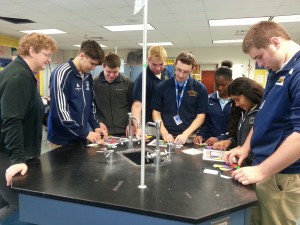
Students at Riley High School recently attended a QuarkNet masterclass to learn how to analyze data from the CMS experiment at CERN. Photo courtesy of Susan Sakimoto
As organizations and institutions around the United States push for higher standards in science and mathematics education, some communities have to get creative in finding sufficient resources to meet these expectations. One teacher in South Bend, Indiana, reached out for better opportunities for its students.
On March 18, Riley High School juniors and seniors attended a QuarkNet masterclass to discuss some of the research and analysis they conducted during this spring semester. According to a 2015 Indiana Department of Education review, Riley is one of the more diverse schools in the state: Nearly 30 percent of its student population is black, and 20 percent are Hispanic.
During the QuarkNet program, the students received first-hand experience working with data from the CMS experiment at CERN.
“The masterclass helps students understand how we reconstruct data in our detectors and identify the mass of each particle event in the data collected,” said Daniel Karmgard, a Fermilab visiting scientist, QuarkNet mentor and a physics professor at the University of Notre Dame. “Part of what we’re showing them is how to apply concepts they have already learned in the classroom to particle physics.”
The one-day masterclass is meant to provide an engaging way for students to do physics – one that closely resembles how particle physicists do their own research.
“The usual classroom science course can be quite bland because of all the worksheets and normal labs done in high school,” said Ben Dowd, an 18-year-old senior participating in QuarkNet masterclass program. “I really enjoyed listening to our masterclass mentor; he was very educated, and I felt like I learned a lot from him. He explained some of his work on CMS, then during the videoconference, the moderators explained what they did at Fermilab with their research, and it was extremely fascinating.”
In the few weeks leading up to the masterclass, the students were introduced to particle physics, learned how to analyze the data coming from the LHC and then got started on research and analysis. On the day of the masterclass, students from teacher Susan Sakimoto’s class at Riley went to Notre Dame University and attended a videoconference moderated by Fermilab physicists. Students from Zurich, Switzerland, and Catania, Italy, also pooled their results from their CMS data analysis and joined the conversation.
Depending on the results the students obtained, the QuarkNet mentor and moderators can show the students evidence of a Z boson, J/Psi and Upsilon mesons or the Higgs boson.
“My students always enjoy this experience,” Sakimoto said. “They like learning something real and having their own data. It’s also a great link to the Higgs boson news events, since the students find some Higgs boson candidates.”
Erik Bidwell, an 18-year-old senior who attended the masterclass, said he is doing an independent study on Einstein’s theory of relativity this semester.
“I never understood how much the LHC incorporated relativity in their particle physics research,” Bidwell said. “I was already interested in pursuing a job in science, but the masterclass allowed me to expand my knowledge of a future in physics, and the topic interests me more than ever before.”
The QuarkNet masterclass program proved to be an effective way to teach students applicable and collaborative physics. Interested teachers submit requests to a QuarkNet program for their physics students to participate in masterclasses.
Prior to teaching at Riley, Sakimoto was a geophysics assistant professor at Notre Dame and a research scientist at NASA’s Goddard Space Flight Center in Maryland. This is the third year she introduced her Riley students to QuarkNet, and she is delighted by their enthusiasm.
“QuarkNet masterclasses help all of my students stay interested in physics and willing to participate,” she said. “It is particularly welcome in sparking interest in women and minorities, who are traditionally not well-represented in physics.”
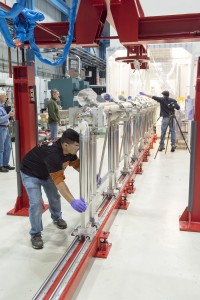
Members of the Fermilab Technical Division line up eight superconducting accelerator cavities to form a cavity string destined for SLAC National Accelerator Laboratory’s LCLS-II. Photo: Reidar Hahn
In February, a Fermilab team came together to witness a moment they’d looked forward to for over a year. Crew members parted the plastic sheeting at one end of a cleanroom and rolled out on narrow tracks a long string of eight accelerating cavities. It was the first cavity string for LCLS-II, which will greatly increase the power and capacity of SLAC’s Linac Coherent Light Source.
Accelerating cavities are structures that impart energy to a particle beam, and they’re the heart of the cryomodule — a major accelerator section — that Fermilab has designed and is building for LCLS-II.
“It’s a big deal. The cavity string’s all bolted up — it’s beautiful,” said SLAC scientist Marc Ross, LCLS-II cryogenics systems manager. “It’s a concrete step toward LCLS-II’s realization.”
SLAC’s LCLS-II is a powerful X-ray laser that will allow scientists to glimpse nature’s fundamental processes on an atomic level and ultrafast time scales. Today SLAC announced DOE approval of the start of construction for LCLS-II.
Since the rollout, the Fermilab team has been outfitting the cavity string with cooling equipment, instrumentation and structural support to form the cryomodule. By summer, they will have completed their first one.
“To me this is a major milestone because it shows that we can do it,” said Camille Ginsburg, the cryomodule team lead for the Fermilab LCLS-II effort. “It represents having tested all of those cavities successfully, finalized the design and put together all the assembly infrastructure that was required.”
The cryomodule is destined for LCLS-II’s new superconducting linear accelerator. Electrons speeding down the accelerator will generate an almost continuous X-ray laser beam with pulses of up to a million times per second — thousands of times faster than the current LCLS puts out. To be superconducting, the cryomodule’s cavities, made of niobium, must operate at minus 456 degrees Fahrenheit.
The linear accelerator backbone of LCLS-II comprises 37 cryomodules. Thomas Jefferson National Accelerator Facility in Virginia, another LCLS-II collaborating institution, will build 18 cryomodules of this type. Fermilab is building 17 of these cryomodules plus two that will operate at a higher frequency.
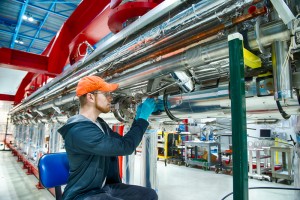
Andrew Penhollow of the Fermilab Technical Division tends to the LCLS-II prototype cavity string, which is seen here mounted to cooling infrastructure. Photo: Reidar Hahn
The boost from a pulsed beam to a continuous one means that the new accelerator will require much more power to operate. And with great power comes the need for great efficiency.
That’s why Fermilab scientists have, for the better part of a decade, been working on methods for building and treating cavities to be as efficient as they can be. By imparting maximum energy to the beam with minimal energy loss, efficient cavities help drive down the cost.
Last year, the Fermilab team reported a world-record quality factor, an indicator of the cavity’s efficiency in minimizing thermal losses.
“The performance of the individually tested cavities that were put into the string was far beyond anything that has been put into such a cryomodule before,” Ross said.
Fermilab also designed the cryomodule’s instrumentation to be able to handle the high power and its plumbing system to carry away heat.
“With continuous-wave operation, there’s a much higher heat load than there is with pulsed-beam acceleration, so everything has to be more robust,” said Fermilab’s Elvin Harms, who leads cryomodule testing for LCLS-II at Fermilab.
Scientists and engineers specially designed the couplers that transfer the radio-frequency power to the cavities with thicker, high-conductivity plating, for example, to carry away the high heat load.
The assembly process to this point has been painstaking, said Fermilab scientist Anna Grassellino, who is responsible for cavity preparation and testing for LCLS-II. And it promises to remain that way until the cryomodule is finally delivered to SLAC.
“Everything that’s happening now with the cryomodule assembly — every step is critical,” Grassellino said. “How you handle the parts can affect performance.”
Technicians who successfully assembled the first cavity string in the cleanroom spent two weeks carefully putting the components together. Following a protocol established at DESY in Germany and Saclay in France and borne out in tests at the Fermilab Accelerator Science and Technology facility, they moved in slow motion, since too-rapid movements would create particulates that could make their way into the cavity, degrading its operation in an accelerator.
“These techniques that seem ancillary are actually quite sophisticated,” Grassellino said. “When the cavity string was finished, it was, ‘Phew! Now it’s sealed, now it rolls out.’”
Crews are carefully installing shielding to protect the cavities from Earth’s magnetic field, which would ruin their performance; welding the cavity string to the plumbing for the super-cooled helium that will keep the cavities cold; and connecting everything structurally inside the vacuum vessel.
Cryomodule tests will begin early this summer. Fermilab and Jefferson Lab plan to move the completed cryomodules to SLAC toward the end of 2016.
“Congratulations to the entire cryomodule team here, at Jefferson Lab and at SLAC,” said Rich Stanek, Fermilab LCLS-II senior team leader. “We’re working hard to deliver cryomodules that meet or exceed specifications within the project cost and schedule.”
LCLS-II, like its predecessor LCLS, will be a DOE Office of Science User Facility.
Today Italian Prime Minister Matteo Renzi visited Fermi National Accelerator Laboratory to celebrate nearly four decades of collaboration between Fermilab and Italy. Renzi met with Fermilab Director Nigel Lockyer and Italian researchers to discuss the many contributions Italy — and Italian scientists, engineers and students — have made and continue to make to Fermilab and to particle physics research.
While at Fermilab, Renzi toured an operations center that serves as a hub for Fermilab’s neutrino experiments and a technical area where high-tech, Italian-made particle accelerator components are assembled.
“The world of research is now global and interconnected,” Renzi said, addressing a group of about 50 Italian scientists, engineers and students gathered to welcome him to the lab.
As a significant contingent on Fermilab’s CDF experiment, Italian scientists were among those who discovered the top quark in 1995. It was a major success of the relationship with the Italian National Institute of Nuclear Physics, or INFN, that started in the early 1980s.
“Our involvement is not only at the level of the physics, but also at technology, and also our industry,” said INFN Vice President for Research Antonio Masiero. “We think that, working together, we can have a mutual benefit from both institutions.”
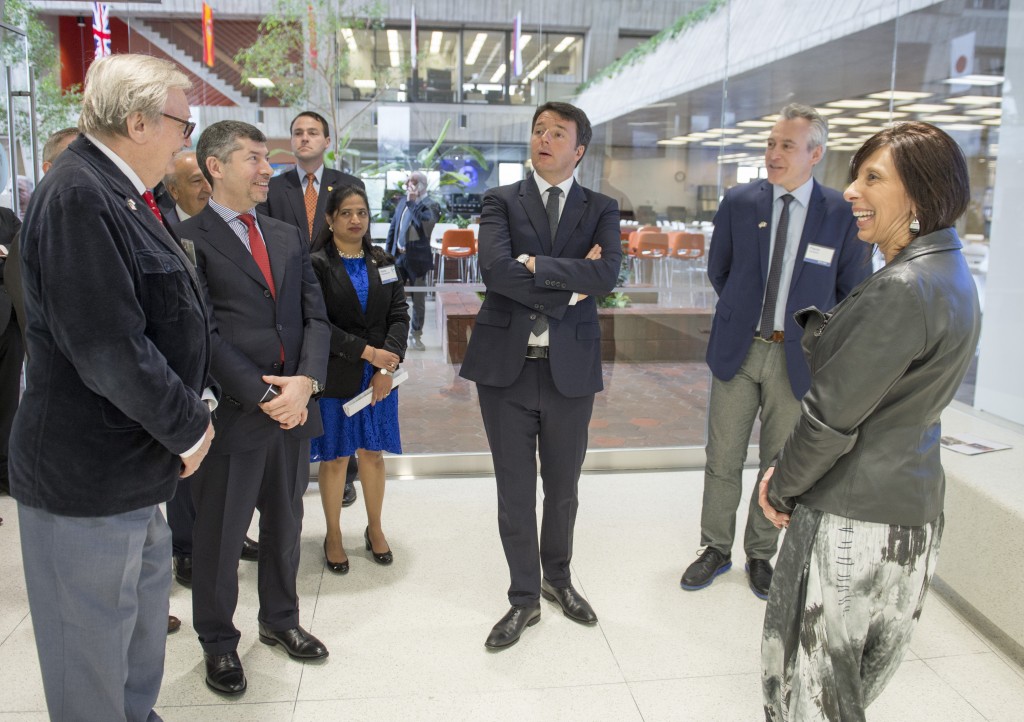
Italian Prime Minister Matteo Renzi (center) tours the Remote Operations Center West at Fermilab and learns about neutrinos. Photo: Fermilab
Fermilab scientist Luciano Ristori noted that one of Italy’s — and the world’s — great physicists made an important contribution to the laboratory in nothing less than its very name.
“We are all extremely proud of the fact that this important American research laboratory is named after the great Italian Enrico Fermi,” Ristori said, addressing Prime Minister Renzi.
Prime Minister Renzi was accompanied by Italian officials including Ambassador Armando Varricchio, Deputy Minister of Economic Development Ivan Scalfarotto, and Consul General of Italy in Chicago Adriano Monti. Prominent scientists from Italy traveled to Fermilab to celebrate the occasion, including Carlo Rubbia, a Nobel Prize-winning physicist, senator-for-life of the Italian Republic and former director general of the European laboratory CERN; Antonio Masiero, INFN vice president for research; and Sergio Bertolucci, INFN coordinator for the future Deep Underground Neutrino Experiment, or DUNE, to be hosted by Fermilab.
Italian contributions to Fermilab are felt throughout the laboratory’s R&D programs. Rubbia developed the revolutionary liquid-argon detector technology behind several Fermilab neutrino experiments, including the flagship experiment DUNE, enabling researchers to study neutrino interactions in a new way.
“Fermilab helps CERN bring forward its flagship program, the LHC,” Bertolucci said. “CERN helps Fermilab to bring forward its flagship program, DUNE. And all the funding agencies, like INFN in Italy, they are working on both projects. It’s a nice synergy.”
Italian institutions have strong, ongoing partnerships with DUNE, its supporting Long-Baseline Neutrino Facility and Fermilab’s Short-Baseline Neutrino Program. Fermilab will reuse the detector for Rubbia’s ICARUS neutrino experiment, being upgraded at European laboratory CERN, which ran at the Italian Gran Sasso Laboratory from 2010-14.
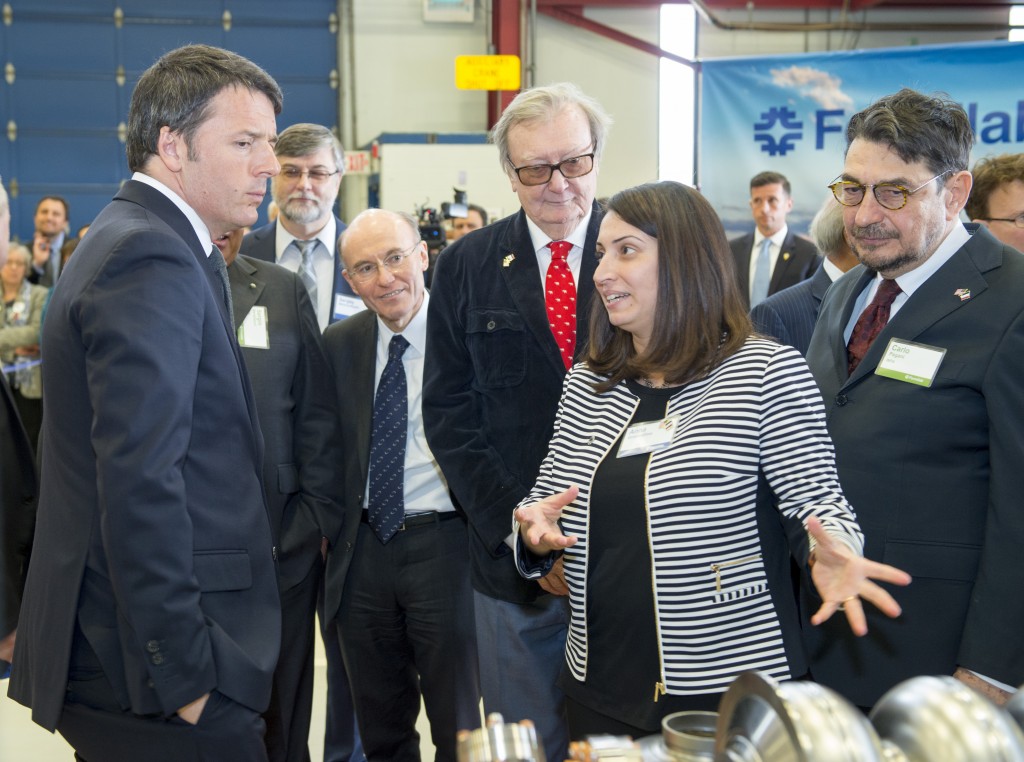
Fermilab scientist Anna Grassellino explains accelerator technology on display at the laboratory’s Technical Campus to Italian Prime Minister Matteo Renzi. Photo: Fermilab
“Italy is the beginning of a story, which is becoming a major American story, with neutrinos,” Rubbia said. “So I’m very happy to see how things are developing.”
Italy also plays a major role in Fermilab’s accelerator R&D. The Italian company Ettore Zanon is one of the few in the world capable of manufacturing the superconducting cavities — structures that impart energy to particle beams — designed at Fermilab for next-generation accelerators.
The superconducting magnets that will be used in Fermilab’s Mu2e experiment were designed in a fruitful collaboration between Fermilab and INFN Genoa. The partnership has yielded prototypes that can produce a magnetic field 20 times stronger than their current counterparts.
Young Italian scientists and engineers have had a major positive impact on Fermilab research, including advances made by interns who come to Fermilab through the Italian Graduate Students summer program, which has seen 400 students study at Fermilab over its 30-year history.
“You find at Fermilab that of 2,000 people, 130 are Italians,” Renzi said. “Research teams here are headed by Italians, and they are doing a great job. The important thing for us is to give Italians the opportunity not only to show the value of ‘made in Italy’ technology, but also to show the skills Italians learn in Italy. Most of these people graduated from Italian universities.”
Before departing Fermilab, Renzi met many members of Fermilab’s Italian community, including scientists, engineers, technicians and students, who will continue to strengthen the bonds between the laboratory and Italy into the future.
“There’s a special relationship between Italy and the U.S., and in particular between the science that’s taking place in Europe, at CERN, at Gran Sasso and also at Fermilab,” Lockyer said. “The Prime Minister said he could feel the passion for our science here. The future is looking great.”
